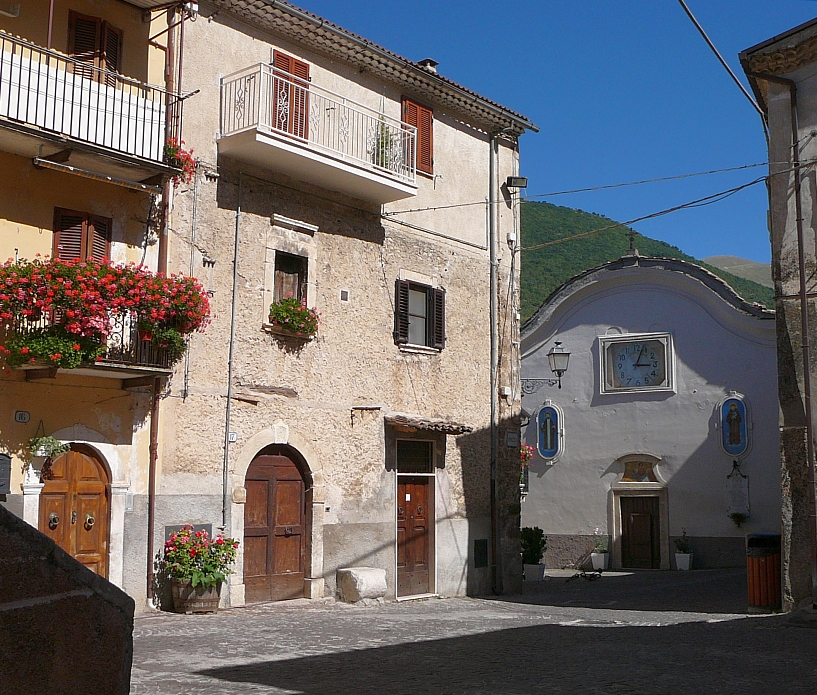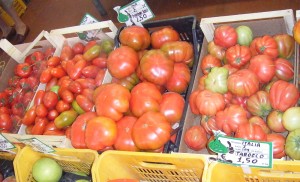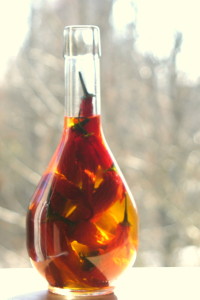 If you love hot chillies, we suggest you fry 3 or 4 really hot ones, whole, with half a glass of olive oil for about 5-10 minutes, switching off the heat before the chillies start burning. Then, you can use one or two teaspoons of this oil to sprinkle on soups and pastas that require some hot chilli taste. This chilli oil will keep for several weeks, if kept in the fridge.
If you love hot chillies, we suggest you fry 3 or 4 really hot ones, whole, with half a glass of olive oil for about 5-10 minutes, switching off the heat before the chillies start burning. Then, you can use one or two teaspoons of this oil to sprinkle on soups and pastas that require some hot chilli taste. This chilli oil will keep for several weeks, if kept in the fridge.
Saffron
Saffron is one of the key ingredients of risotto. It was first introduced to Abruzzo by a Jesuit priest returning from Spain, where he was working with the Inquisition. His brother successfully raised the autumn crocus from which saffron is produced on the Plain of Navelli, an area of somewhat scrubby flat 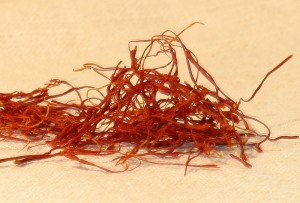 fields amongst the mountains, where saffron farms are still found. The plant has a small pale purple flower, and it is the yellow stigma which is used to make saffron. It is said to have medicinal properties, as a relaxant or stimulant – and many claim it has aphrodisiac properties. Abruzzo is one of two places in Italy where this precious crop is grown. Buy it for this recipe either in powder form or as dried threads of the stigmas to be pounded just before use.
fields amongst the mountains, where saffron farms are still found. The plant has a small pale purple flower, and it is the yellow stigma which is used to make saffron. It is said to have medicinal properties, as a relaxant or stimulant – and many claim it has aphrodisiac properties. Abruzzo is one of two places in Italy where this precious crop is grown. Buy it for this recipe either in powder form or as dried threads of the stigmas to be pounded just before use.
Roseto degli Abruzzi
Roseto degli Abruzzi, Ada’s home town, has changed beyond recognition over the last 50 years: from a small village with an economy based upon fishing and the provision of various services to the inland villages, to a holiday resort and bustling little town.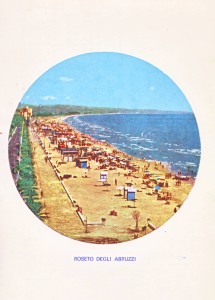
Communications were always easier along the coast, and the main road, the railway and the autostrada (highway) all now follow this north-south route, seemingly rather contemptuous of the multitude of villages and hamlets sprinkled over the valleys and mountains away from the coast.
Whereas once the beach was empty most of the year, except for the small open lateen rigged fishing boats and a limited number of privileged tourists during the peak of summer, it is now overpopulated during the summer months with hundreds of people, with all their attendant needs for lines of sun umbrellas, tables and chairs – all neatly arranged on a precise grid, each lido in its own regimental colours, ranks set facing the sea, with a bar providing the necessary flow of pizza, beers, and aperitivi or bitters. Miraculously, this all disappears at the end of the summer season, and all the paraphernalia of summer daily life on this Adriatic beach vanish into its winter quarters within a few days in mid-September. The paradox of such order and precision in the beach arrangements in Italy – a country usually associated with a more relaxed, less well regulated and spontaneous way of life – might seem perplexing to some.
The changes in the economy have been reflected in the buildings and squares of the town itself. Although marble, stainless steel and plate glass dominate its commercial buildings and shops today, there are still remnants of a previous, more traditional and less egalitarian age. When very few people could afford a holiday, the advantages of a seaside escape to Roseto were confined to the aristocracy from the urban areas of Bologna and Roma. They built villas in the “primo novecento” style, mostly from a yellowish brick under heavy clay tile roofs, in classical elegant proportions. Some of these buildings still remain, although many are in poor repair, seemingly abandoned to gradual decay, surrounded for the most part by neat but characterless apartment buildings.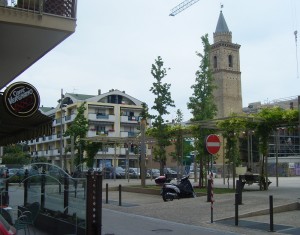
Within the town centre, a long strip of modern shops runs parallel to the railway line, some clearly a modern facade on an older building, which shows its origins in more rustic times through the details of its brickwork, where arches above now bricked up windows and doorways can be seen. The town is still centred upon the square in front of the station, where the pace of life is reflected in the three bars, each with their regular patrons – most of them men – all engaged in self-important discussion, punctuating their conversation with emphatic gestures, whilst the town policemen idle away their time in the centre of the square, dressed in immaculate uniforms, accompanied by an intimidating arrangement of belts and leather work to support the large gun each one carries.
Even now, nestling among the boutiques with the latest United Colours of Benetton and especially in the back streets, are the traditional pasticcerie and pasta shops. This is where many locals come to buy the pasta all’uovo needed for some of the dishes in this section of this cooking book: the ravioli with ricotta cheese, the maccheroni alla chitarra, the agnolotti, and so on. People leave the shops with neat little trays of pasta, looking for all the world like a gift-wrapped present from Saks on 5th Avenue, New York. But the packages are prepared with infinitely more care, such is the reverence paid to pasta in Roseto.
One tradition still strong in Abruzzo is the annual preservation of tomatoes at the end of the harvest season, and we witnessed this bottling process just beginning in Castrovalva.
Near Cocullo, on a road that twists its way through the narrow passes and tunnels towards the Serra di Bocca Chiarano, by way of Scanno, there is a small side road making its way up to the village of Castrovalva. The village itself seems to have grown from the solid rock on the crest of the hill, the sheer rock rising to become the outer walls of the buildings. The road looks like a thin silver bracelet dropped from the sky, left just where it fell, and on the day we were there, it glistened in a few, rare rays of evening sun, on an otherwise overcast, wet and windswept day. One final turn and we were at the threshold of a short and finely engineered tunnel, straight through the hill, and out on the other side. Wide enough for one vehicle, this is the only access to the village, the cars having to squeeze through this passage. But this is not a problem: traffic is minimal here.
The village itself is a bewildering labyrinth of narrow streets, steeply climbing this way and that, through arches and up stairs, every building fitted into the available space, no two the same. On the day of our visit the streets were deserted, with just a wisp of smoke from some chimneys intimating a cosy refuge from the wind and rain driving across the mountain tops of the surrounding Appennino Abruzzese.
We turned one corner, and caught the sound of a bar: a low rumbling of village gossip, chairs scraping over flagstone floors, and glasses and bottles being placed heavily on wooden tables. That could only be an early evening gathering of the menfolk of the village – we heard no women’s voices – or maybe the aftermath of a late lunch. It seemed unlikely that anyone could be working, there: what would they do, and why would they be doing it there in that remote eyrie.
We met an old man, head bent into the wind and lashing rain, who did not seem too surprised to meet strangers on such a day, and in such weather. He greeted us, and pointed us the direction to the best view, which was indeed fine, since we seemed to be at the height of the surrounding peaks. There have, however, been better days on which to enjoy the view of the valleys below us, so we hurried back to the sanctuary of our car.
But there, near to the point that marks the margins of the settlement, was a large drum, with a low fire underneath it. Late August, the end of summer, is the season for the preparation and bottling of tomatoes, and the boiling water in the drum is used to sterilise the jars of freshly picked pomodori.
Roseto is something of a metropolitan centre, compared to Castrovalva, but it is still a mixed society of visitors from the big cities and the original rural inhabitants. It is those folk with strong ties to the rural areas and countryside ways who, in late August, are seen unloading large quantities of ripe tomatoes for bottling from small pickups and their three-wheeled versions, based upon a lambretta or scooter and always in the same drab oily blue or grey, some known as “Ape” or bee. Old men lift crate after crate from the pickup, which gradually returns to its normal profile and height above the road, as the suspensions recovers. The tomatoes themselves are large, craggy, pockmarked and corrugated – but what a taste: so much better than the insipid but uniform big city alternatives found in other countries.
Tomatoes are still revered as one of the main ingredients of many sauces for pasta dishes. However, there is more to Italian pastas and sauces than usually acknowledged. In this section of our cooking book we will start by describing some of the pasta dishes that we fancy most – with well-known as well as less well-known sauces, all of them freshly prepared from scratch.
Utensils and Ingredients
Special utensils may be of use in making some of the dishes. The passapatate (center bottomof the photo) is for forcing potatoes or various other ingredients either into a mashed form, or, as in one recipe, to make thick spaghetti-like shapes.
Then there is the mezzaluna or ‘half moon’ (bottom right of the photo), for chopping (see 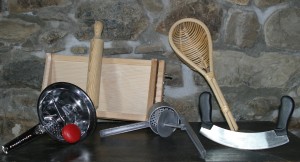 the recipe for Crostoni). The passaverdura (bottom left) is used to reduce cooked vegetables to a creamy consistency but, unlike the electric-powered liquidizer, it leaves the fibrous material out of the final mixture. The chitarra (left, against the wall) is used for cutting pasta, and has a series of wires upon which the pasta dough is placed and then, using a rolling pin, forced through the wires in order to cut it into its final form. See the recipe for Maccheroni alla chitarra, where the pasta should be prepared with the chitarra, of course, if you have it available.
the recipe for Crostoni). The passaverdura (bottom left) is used to reduce cooked vegetables to a creamy consistency but, unlike the electric-powered liquidizer, it leaves the fibrous material out of the final mixture. The chitarra (left, against the wall) is used for cutting pasta, and has a series of wires upon which the pasta dough is placed and then, using a rolling pin, forced through the wires in order to cut it into its final form. See the recipe for Maccheroni alla chitarra, where the pasta should be prepared with the chitarra, of course, if you have it available.
When using Parmesan cheese, it is vital to use only the best quality, and avoid the already grated cheese in jars or plastic containers. Buy a piece of Parmesan cheese and grate it fresh for each dish that requires it.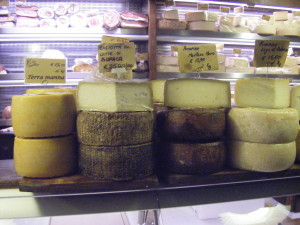
The same is true for prosciutto (Parma ham). Make sure it is of the best quality: it should be seasoned, but not too salty. Buy the best you can find.
When you cook pasta, it is essential to remove it from the boiling water when still al dente. That is when it has a little ‘bite’ left, and is definitely not soft. Take care not to overcook any pasta, and look on the packet for the recommended cooking times. Cook it uncovered (although you will leave the cover on the pan for a while just after adding the pasta to boiling water in order to bring it back to the boil quickly). Before adding the pasta, always ensure that the water is boiling briskly, and the pan is large and has plenty of water. Do not cook the pasta before preparing the sauce: on the contrary, always make sure that the sauce is ready before putting the pasta into the boiling water. Once cooked, pasta has to be drained quickly, mixed with its sauce, served and eaten immediately – otherwise it overcooks in the serving dish, and could as well be thrown away.
Olive oil should always be of the best quality. So, use extra virgin, first cold pressing if possible.
Growing your own herbs is another way to ensure a supply of fresh rosemary, basil, sage and so on. Some plants can be grown indoors or at least purchased as live plants and kept indoors until you are ready to use them – they may not thrive in the longer term.
As for the wine, let us give you and old proverb from Nicola Mastropietro, grandfather of our friend Susan:
Vino vinelle
se’ sabrit’e belle
se’ nat’al fresche
me fa’ parla’ tedesche.
‘Na mane te prentre
una t’abraze
a la salute…
te men’a corde.
Which could be (roughly…) translated as “Wine, nice wine, you are tasty and beautiful, you were born in the coolness, you make me speak foreign languages. One hand holds you, one hand hugs you, to your health…. it goes down to the heart”. When a recipe calls for wine, use only wine that is good to drink, and taste it to make sure that it is not `corked` – that is to say, check that it does not taste of cork, a problem that might occur when wine reacts with the cork in the bottle during storage.
Italiani i più longevi in Europa – 81 anni
Link

Italiani i più longevi in Europa: 81 anni. Gli inglesi: “Fumate e bevete, inspiegabile”

